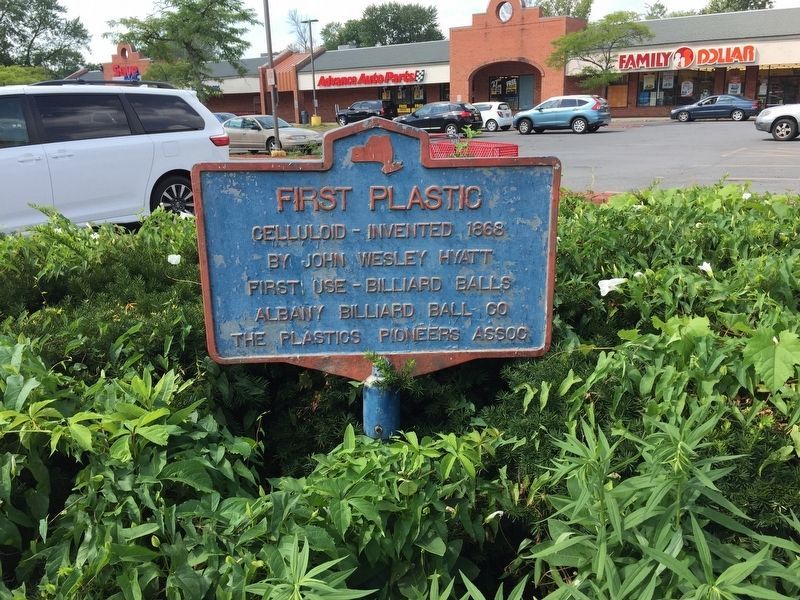DelSo in Albany in Albany County, New York — The American Northeast (Mid-Atlantic)
First Plastic
Inscription.
Celluloid-invented 1868 by John Wesley Hyatt
First Use- Billiard Balls
Albany Billiard Ball Co.
Erected by Plastic Pioneers Assoc.
Topics. This historical marker is listed in these topic lists: Industry & Commerce • Science & Medicine. A significant historical year for this entry is 1868.
Location. 42° 38.382′ N, 73° 47.174′ W. Marker is in Albany, New York, in Albany County. It is in DelSo. Marker is on Delaware Avenue. Touch for map. Marker is in this post office area: Albany NY 12209, United States of America. Touch for directions.
Other nearby markers. At least 8 other markers are within 2 miles of this marker, measured as the crow flies. Lincoln Park (approx. 1.3 miles away); Washington Park (approx. 1.3 miles away); A History of the Albany County Helderberg-Hudson Rail Trail (approx. 1.3 miles away); The Battle of Henry Johnson (approx. 1.3 miles away); Origins of the Albany Tulip Festival (approx. 1.3 miles away); Uncle Dan (approx. 1.3 miles away); Boats and Music (approx. 1.3 miles away); Schuyler Mansion (approx. 1.4 miles away). Touch for a list and map of all markers in Albany.
More about this marker. This is the site of the Albany Billiard Ball CO.
Regarding First Plastic. John Hyatt patented celluloid April 6, 1869. He intended to use it as a substitute for ivory in the production of billiard balls. It was a good match for ivory in elasticity and density; however, the combustibility of nitrocellulose, the principle ingredient of celluloid, could cause a small explosion when two balls collided violently.
In the mid-nineteenth century, billiard balls were made of ivory. The growing popularity of the game, along with a common belief that ivory was in short supply, led to a search for an ivory substitute. Phelan and Collender, a leading manufacturer of billiard supplies, offered a $10,000 reward to find one.
Celluloid is prepared by a complicated 23 step process that combined several ingredients including camphor, alcohol, acid with 70-80% nitrocellulose. Nitrocellulose, also known as pyroxylin, flash paper and gun cotton, is highly flammable, and certain conditions, explosive.
Occasionally, as Hyatt himself recalled, two balls hitting each other would produce “a mild explosion like a percussion guncap.” “We had a letter from a billiard saloon proprietor in Colorado, mentioning this fact and saying that he did not care so much about it, but that instantly every man in the room pulled his gun.”
Also see . . . Exploding billiard balls - Smithsonianmag.com. (Submitted on September 5, 2018, by Steve Stoessel of Niskayuna, New York.)
Credits. This page was last revised on February 16, 2023. It was originally submitted on September 3, 2018, by Steve Stoessel of Niskayuna, New York. This page has been viewed 458 times since then and 43 times this year. Last updated on February 16, 2019, by Steve Stoessel of Niskayuna, New York. Photo 1. submitted on September 3, 2018, by Steve Stoessel of Niskayuna, New York. • Andrew Ruppenstein was the editor who published this page.
